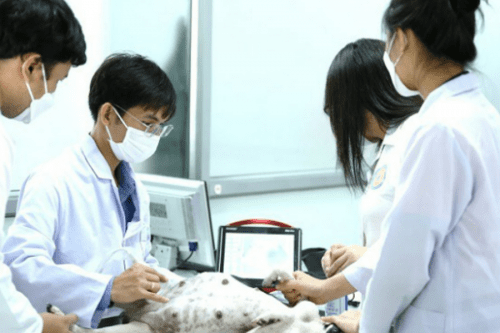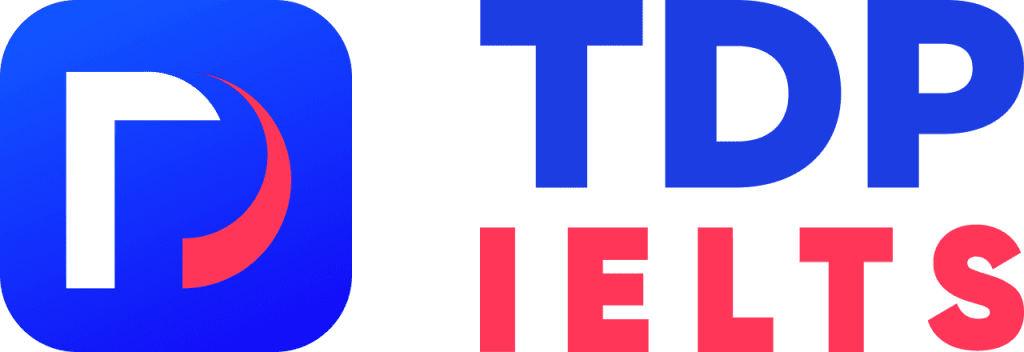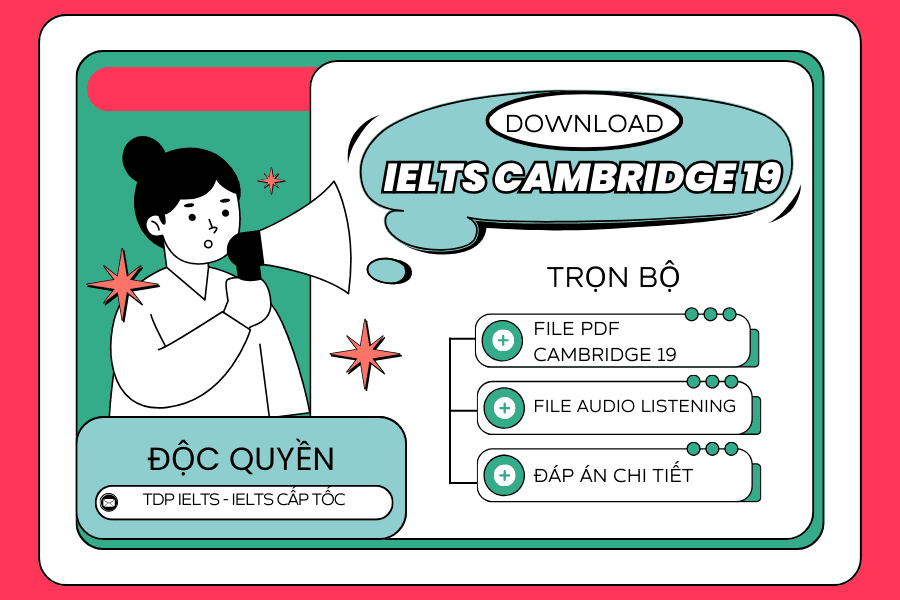Bác sĩ là người mà chúng ta nghĩ đến khi gặp bệnh, nếu bạn đang học tập tại nước ngoài, việc giao tiếp với họ là rất quan trọng. Hãy cùng TDP IELTS học thêm các từ vựng tiếng Anh chuyên ngành Y – Bác sĩ nhé!

Xem thêm:
– Từ vựng tiếng Anh chuyên ngành cơ khí
– Từ vựng tiếng Anh chuyên ngành bóng đá
– Từ vựng tiếng Anh chuyên ngành bán lẻ
– Từ vựng tiếng Anh chuyên ngành bếp
Nội dung
ToggleTừ vựng tiếng Anh chuyên ngành Y – Bác sĩ đa khoa
Từ vựng tiếng Anh chuyên ngành Y – Bác sĩ: Các loại bệnh viện
Các loại bệnh viện là các Từ vựng tiếng Anh chuyên ngành Y – Bác sĩ cực phổ biến trong hội thoại về y khoa. Bỏ túi ngay các Từ vựng tiếng Anh chuyên ngành Y – Bác sĩ sau:
- Hospital – /ˈhɑːspɪtl/: Bệnh viện
Ví dụ: “The hospital provides medical care to the community.
- Children hospital – /ˈʧɪldrən ˈhɑːspɪtl/: Bệnh viện nhi
Ví dụ: “The children’s hospital specializes in pediatric care and treatment.”
- General hospital – /ˈdʒenrəl ˈhɑːspɪtl/: Bệnh viện đa khoa
Ví dụ: “The general hospital offers a wide range of medical services for various health conditions.”
- Dermatology hospital – /ˌdɜːrməˈtɑːlədʒi/ ˈhɑːspɪtl/: Bệnh viện da liễu
Ví dụ: “The dermatology hospital focuses on the diagnosis and treatment of skin disorders.”
- Field hospital – /fiːld ˈhɑːspɪtl/: Bệnh viện dã chiến
Ví dụ: “A field hospital was set up to provide emergency medical care during the crisis.”
- Mental hospital – /ˈmentl ˈhɑːspɪtl/: Bệnh viện tâm thần
Ví dụ: “The mental hospital is dedicated to the care and treatment of individuals with mental health disorders.”
- Orthopedic hospital – /ˌɔːrθəˈpiːdɪk ˈhɑːspɪtl/: Bệnh viện chấn thương chỉnh hình
Ví dụ: “The orthopedic hospital specializes in the treatment of musculoskeletal injuries and disorders.”
- Maternity hospital – /məˈtɜːrnəti ˈhɑːspɪtl/: Bệnh viện phụ sản
Ví dụ: “Expectant mothers receive excellent care at the maternity hospital during pregnancy and childbirth.”
- Cottage hospital – /ˈkɑːtɪdʒ ˈhɑːspɪtl/: Bệnh viện tuyến dưới, tuyến huyện
Ví dụ: “The cottage hospital serves the healthcare needs of the local community in rural areas.”
- National hospital – /ˈkɑːtɪdʒ ˈhɑːspɪtl/: Bệnh viện trung ương
Ví dụ: “The national hospital is a major healthcare facility providing specialized medical services.”
- Nursing home – /ˈnɜːrsɪŋ həʊm/: Viện dưỡng lão
Ví dụ: “The nursing home offers long-term care and support for the elderly residents.”
Từ vựng tiếng Anh chuyên ngành Y – Bác sĩ: Các phòng trong bệnh viện
Từ vựng tiếng Anh chuyên ngành Y – Bác sĩ về các phòng trong bệnh viện cũng quan trọng không kém các Từ vựng tiếng Anh chuyên ngành Y – Bác sĩ khác đâu nhé!
- Admission office – /ədˈmɪʃn ˈɑːfɪs/: Phòng tiếp nhận bệnh nhân
Ví dụ: “Patients can inquire about admissions at the admission office.”
- Consulting room – /kənˈsʌltɪŋ rʊm/: Phòng khám bệnh
Ví dụ: “The doctor examines patients in the consulting room to diagnose their conditions.”
- Blood bank – /ˈblʌd bæŋk/: Ngân hàng máu
Ví dụ: “The blood bank plays a crucial role in supplying blood for medical treatments and emergencies.”
- Specimen collecting room – /ˈspesɪmən kəˈlɛktɪŋ rʊm/: Phòng thu nhận bệnh phẩm
Ví dụ: “Specimens are collected and processed in the specimen collecting room for diagnostic purposes.”
- Surgery Suite – /ˈsɜːrdʒəri swiːt/: Khu phẫu thuật
Ví dụ: “The surgery suite is equipped with state-of-the-art facilities for performing surgical procedures.”
- Operating room/theatre – /ˈɑpəˌreɪtɪŋ rʊm/: Phòng mổ
Ví dụ: “Surgeons conduct operations in the operating room, ensuring a sterile and controlled environment.”
- Surgery Room – /ˈsɜːrdʒəri rʊm/: Phòng mổ
Ví dụ: “Patients are prepared for surgery in the surgery room before being taken to the operating room.”
- PreoperativeRRoom – /priˈɑːpərətɪv rʊm/: Phòng tiền phẫu
Ví dụ: “Patients undergo preoperative preparations in the preoperative room prior to surgery.”
- Recovery Room – /rɪˈkʌvəri rʊm/: Phòng hậu phẫu
Ví dụ: “After surgery, patients are monitored and recover in the recovery room before returning to their wards.”
Isolation ward – /ˌaɪsəˈleɪʃn wɔːrd/: Phòng cách ly (hoặc gọi là Isolation room)
Ví dụ: “Patients with contagious diseases are placed in the isolation ward to prevent the spread of infections.”
- On-call room – /ɑːn-kɔːl rʊm/: Phòng trực
Ví dụ: “Doctors and nurses take turns staying in the on-call room for immediate response to emergencies.”
- Waiting room – /ˈweɪtɪŋ rʊm/: Phòng chờ
Ví dụ: “Patients and their families wait in the waiting room for appointments and consultations.”
- Canteen – /kænˈtiːn/: Nhà ăn của bệnh viện
Ví dụ: “Hospital staff and visitors can enjoy meals at the canteen located within the premises.”
- Housekeeping – /ˈhaʊskiːpɪŋ/: Phòng tạp vụ
Ví dụ: “Housekeeping ensures the cleanliness and maintenance of the hospital facilities.”
- Dispensary – /dɪˈspensəri/: Phòng phát thuốc
Ví dụ: “Patients can collect their prescribed medications from the hospital dispensary.”
- Pharmacy – /ˈfɑːrməsi/: Quầy thuốc, hiệu thuốc
Ví dụ: “The pharmacy provides a wide range of medications and pharmaceutical products.”
- Day surgery – /deɪ ˈsɜːrdʒəri/: Đơn vị phẫu thuật trong ngày (hoặc gọi là Operation unit – /ˌɑːpəˈreɪʃn ˈjuːnɪt/)
Ví dụ: “Day surgery allows patients to undergo surgical procedures and return home on the same day.”
- Delivery room – /dɪˈlɪvəri rʊm/: Phòng sinh
Ví dụ: “Expectant mothers are admitted to the delivery room when it’s time to give birth.”
- Emergency room – /ɪˈmɜːrdʒənsi rʊm/ : Phòng cấp cứu (hoặc có thể gọi là Emergency ward – /ɪˈmɜːrdʒənsi wɔːrd/)
Ví dụ: “Patients with urgent medical needs are attended to in the emergency room.”
- Discharge Office – /dɪsˈtʃɑːrdʒ ˈɑːfɪs/: Phòng làm thủ tục ra viện
Ví dụ: “Before leaving the hospital, patients complete discharge procedures at the discharge office.”
- Mortuary – /ˈmɔːrtʃueri/: Nhà xác
Ví dụ: “Deceased individuals are temporarily housed in the mortuary before funeral arrangements are made.”
- Laboratory – /ˈlæbrətɔːri/: Phòng xét nghiệm
Ví dụ: “Medical tests and analyses are conducted in the laboratory to aid in the diagnosis of illnesses.”
- Medical records department – /ˈmedɪkl ˈrekərd dɪˈpɑːrtmənt/: Phòng lưu trữ hồ sơ bệnh án
Ví dụ: “The medical records department manages and archives patient health records.”
- Sickroom – /ˈsɪkrʊm/: Buồng bệnh
Ví dụ: “Patients who need isolation or rest are accommodated in the sickroom.”
- Nursery – /ˈnɜːrsəri/: Phòng trẻ sơ sinh
Ví dụ: “Newborns are cared for in the nursery, where they receive attention from nurses and doctors.”

Từ vựng tiếng Anh chuyên ngành Y – Bác sĩ: Các khoa/đơn vị chức năng
Từ vựng tiếng Anh chuyên ngành Y – Bác sĩ về chủ đề này sẽ rất hữu ích trong các cuộc đối thoại có sử dụng Từ vựng tiếng Anh chuyên ngành Y – Bác sĩ.
- Diagnostic imaging – /ˌdaɪəɡˈnɑːstɪk ˈɪmɪdʒɪŋ/ : Khoa chẩn đoán hình ảnh (hoặc có thể gọi là X-ray department – /ˈeks reɪ dɪˈpɑːrtmənt/).
Ví dụ: “Patients undergo diagnostic imaging to identify and diagnose medical conditions.”
- Labour ward – /ˈleɪbər wɔːrd/ : Khu sản phụ
Ví dụ: “Expectant mothers are admitted to the labour ward when in active labor.”
- Inpatient department – /ˈɪnpeɪʃnt dɪˈpɑːrtmənt/: Khoa bệnh nhân nội trú
Ví dụ: “The inpatient department provides care for patients who require hospitalization.”
- Outpatient department – /ˈaʊtpeɪʃnt dɪˈpɑːrtmənt/: Khoa bệnh nhân ngoại trú
Ví dụ: “Outpatient services are offered in the outpatient department for those who do not require hospitalization.”
- Pediatrics department – /ˌpiːdiˈætrɪks dɪˈpɑːrtmənt/: Khoa nhi (gọi tắt là Pediatrics dept)
Ví dụ: “The pediatrics department specializes in the medical care of children and adolescents.”
- Gastroenterology Dept – /ˌɡæstrəʊˌentəˈrɑːlədʒi dɪˈpɑːrtmənt/: Khoa nội tiêu hóa
Ví dụ: “Gastroenterology department focuses on the diagnosis and treatment of digestive system disorders.”
- Respiratory Dept – /ˈrespərətɔːri dɪˈpɑːrtmənt/ : Khoa Nội Hô hấp
Ví dụ: “The respiratory department deals with disorders of the respiratory system.”
- Nutrition & Dietetics – /nuˈtrɪʃn & ˌdaɪəˈtetɪks/: Khoa dinh dưỡng
Ví dụ: “The nutrition and dietetics department provides guidance on healthy eating habits.”
- Endocrinology Dept – /ˌendəʊkrɪˈnɑːlədʒi dɪˈpɑːrtmənt/: Khoa nội tiết
Ví dụ: “Endocrinology department specializes in the diagnosis and management of hormonal disorders.”
- Medicine Dept – /ˈmedɪsn dɪˈpɑːrtmənt/: Khoa nội tổng hợp (hoặc có thể gọi là General Medical)
Ví dụ: “The medicine department provides comprehensive medical care for various health conditions.”
- Emergency Room – /ɪˈmɜːrdʒənsi rʊm/: Khoa Cấp cứu
Ví dụ: “Patients with urgent medical needs are treated in the emergency room.”
- Tuberculosis Dept – /tuːˌbɜːrkjəˈləʊsɪs dɪˈpɑːrtmənt/: Khoa lao
Ví dụ: “The tuberculosis department focuses on the diagnosis and treatment of tuberculosis.”
- Neurology Dept – /nʊˈrɑːlədʒi dɪˈpɑːrtmənt/: Khoa Nội Thần kinh
Ví dụ: “Neurology department specializes in the diagnosis and treatment of neurological disorders.”
- Trauma – Orthopedics Dept – /ˈtraʊmə – ˌɔːrθəˈpiːdɪks dɪˈpɑːrtmənt/ : Khoa Chấn thương chỉnh hình
Ví dụ: “The trauma-orthopedics department deals with injuries and disorders of the musculoskeletal system.”
- Infectious Diseases Dept – /ɪnˈfekʃəs dɪˈziːz dɪˈpɑːrtmənt/ : Khoa Bệnh nhiễm
Ví dụ: “The infectious diseases department focuses on the diagnosis and treatment of infectious diseases.”
- Musculoskeletal system Dept – /Musculoskeletal ˈsɪstəm dɪˈpɑːrtmənt/: Khoa Cơ xương khớp
Ví dụ: “The musculoskeletal system department deals with conditions affecting muscles and bones.”
- Operation Theatre – /ˌɑːpəˈreɪʃn ˈθiːətər/: Khoa phẫu thuật
Ví dụ: “Surgical procedures are performed in the operation theatre.”
- Cardiology Dept –/ˌkɑːrdiˈɑːlədʒi dɪˈpɑːrtmənt/: Khoa Nội tim mạch
Ví dụ: “Cardiology department specializes in the diagnosis and treatment of heart-related conditions.”
- Physical therapy Dept – /ˈfɪzɪkl ˈθerəpi dɪˈpɑːrtmənt/: Khoa Vật lý trị liệu
Ví dụ: “The physical therapy department provides rehabilitation services for patients.”
- Outpatient Dept – /ˈaʊtpeɪʃnt dɪˈpɑːrtmənt/: Khoa khám bệnh
Ví dụ: “Outpatient department offers medical consultations and treatments for non-hospitalized patients.”
- Obstetrics & Gynaecology Dept – /əbˈstɛtrɪks&ˌɡaɪnəˈkɑːlədʒi dɪˈpɑːrtmənt/: Khoa phụ sản
Ví dụ: “Obstetrics and gynecology department specializes in women’s reproductive health.”
- Urology Dept – /jʊˈrɑːlədʒi dɪˈpɑːrtmənt/: Khoa tiết niệu
Ví dụ: “Urology department deals with disorders of the urinary system.”
Từ vựng tiếng Anh chuyên ngành y học về các dụng cụ y tế

Các thiết bị y tế là rất thiết yếu trong y khoa. Điểm thêm qua Từ vựng tiếng Anh chuyên ngành Y – Bác sĩ về chủ đề này nào!
- Acid solution – /ˈæsɪd səˈluːʃn/: dung dịch thử axit.
Ví dụ: “The laboratory technician prepared an acid solution for the experiment.”
- Alcohol – /ˈælkəhɔːl/: Cồn sát khuẩn
Ví dụ: “Alcohol is commonly used as a disinfectant in medical settings.”
- Oral rinse – /ˈɔːrəl rɪns/: nước súc rửa, vệ sinh dụng cụ y tế.
Ví dụ: “The dentist recommended an oral rinse to maintain oral hygiene.”
- Ambulance – /ˈæmbjələns/: Xe cứu thương
Ví dụ: “The ambulance rushed to the scene of the accident to provide emergency medical care.”
- Antiseptic – /ˌæntiˈseptɪk/: Thuốc khử trùng
Ví dụ: “Apply antiseptic to the wound to prevent infection.”
- Band-aid – /ˈbænd eɪd/: Băng keo
Ví dụ: “She put a band-aid on the small cut on her finger.”
- Bandage – /ˈbændɪʤ/: Vải băng vết thương
Ví dụ: “The nurse applied a bandage to the injured arm.”
- Bands – /bændz/: Nẹp
Ví dụ: “The doctor used bands to secure the splint in place.”
- Basin – /ˈbeɪsn/: Cái chậu, bồn rửa
Ví dụ: “Fill the basin with water for the patient to wash.”
- Blood pressure monitor /blʌd ˈprɛʃə ˈmɒnɪtə/: Máy đo huyết áp
Ví dụ: “The nurse checked the patient’s blood pressure using a blood pressure monitor.”
- Chart – /tʃɑːrt/: Biểu đồ theo dõi
Ví dụ: “The doctor reviewed the patient’s medical chart to track their progress.”
- Compression bandage – /kəmˈpreʃn ˈbændɪdʒ/: Gạc nén để cầm máu
Ví dụ: “Apply a compression bandage to control bleeding.”
- Cotton balls – /ˈkɑːtn bɔːlz/: Bông gòn (hoặc gọi là Cotton wool)
Ví dụ: “Use cotton balls to clean the wound before applying the antiseptic.”
- Crutch – /krʌtʃ/: Cái nạng
Ví dụ: “The patient used crutches to support themselves while walking.”
Cyst – /sɪst/: Bao đựng xác
Ví dụ: “The doctor identified a cyst during the ultrasound examination.”
- Defibrillator – /diːˈfɪbrɪleɪtər/: Máy khử rung tim
Ví dụ: “In case of cardiac arrest, the medical team used a defibrillator to restore normal heart rhythm.”
- Dentures – /ˈdentʃərz/: Bộ răng giả
Ví dụ: “The elderly patient wore dentures to replace missing teeth.”

- Drill – /drɪl/: Máy khoan
Ví dụ: “The surgeon used a drill during the orthopedic procedure.”
- Dropper – /ˈdrɑːpər/: Ống nhỏ giọt
Ví dụ: “Use a dropper to administer the medication in precise amounts.”
- Dropping bottle – /ˈdrɑpɪŋ ˈbɑːtl/ : Túi truyền
Ví dụ: “The nurse hung the dropping bottle to administer intravenous fluids.”
Từ vựng tiếng Anh chuyên ngành Bác sĩ Y khoa: Các bệnh cơ bản
Một số bệnh cơ bản có thể diễn tả bằng từ vựng tiếng Anh chuyên ngành Y – Bác sĩ, cũng học thêm một số từ vựng tiếng Anh chuyên ngành Y – Bác sĩ về các bệnh cơ bản dưới đây:
- Malaria – /məˈleriə/: Sốt rét
Ví dụ: “Malaria is a mosquito-borne infectious disease that causes recurring fever.”
- Measles – /ˈmiːzlz/: Bệnh sởi
Ví dụ: “Measles is a highly contagious viral infection characterized by fever and a distinctive rash.”
- Mumps – /mʌmps/: Bệnh quai bị
Ví dụ: “Mumps is a viral infection that primarily affects the salivary glands, leading to swelling.”
- Migraine – /ˈmaɪɡreɪn/: Bệnh đau nửa đầu
Ví dụ: “A migraine is a type of headache characterized by intense pain on one side of the head.”
- Nausea – /ˈnɔːziə/: Buồn nôn
Ví dụ: “Certain medications may cause nausea as a side effect.”
- Paralysed – /ˈpærəlaɪz/: Bị liệt
Ví dụ: “After the accident, the patient was paralyzed from the waist down.”
- Pneumonia – /nuːˈməʊniə/: Bệnh viêm phổi
Ví dụ: “Pneumonia is an inflammatory condition of the lung affecting the air sacs.”
- Rheumatism – /ˈruːmətɪzəm/: Bệnh thấp khớp
Ví dụ: “Rheumatism refers to a range of conditions causing pain and inflammation in the joints, muscles, and connective tissues.”
- Sinus pressure –/ˈsaɪnəs ˈpreʃər/: Viêm xoang
Ví dụ: “Sinus pressure can lead to headaches and discomfort around the eyes and face.”
- Skin disease – /skɪn dɪˈziːz/: Bệnh ngoài da
Ví dụ: “Eczema and psoriasis are examples of common skin diseases.”
- Smallpox – /ˈsmɔːlpɑːks/: Bệnh đậu mùa
Ví dụ: “Smallpox, caused by the variola virus, was eradicated through vaccination.”
- Sore throat – /sɔːr θrəʊt/: Đau họng
Ví dụ: “A sore throat is a common symptom of respiratory infections like the flu or cold.”
- Sore eyes – /sɔːr aɪz/: Đau mắt
Ví dụ: “Sore eyes may be a sign of eye strain or an underlying eye condition.”
- Stomachache – /ˈstʌmək eɪk/: Đau dạ dày
Ví dụ: “Eating too quickly or consuming spicy foods can lead to a stomachache.”
- Toothache – /ˈtuːθeɪk/: Đau răng
Ví dụ: “A persistent toothache may indicate an issue such as a cavity or infection.”
- Tuberculosis – /tuːˌbɜːrkjəˈləʊsɪs/: Bệnh lao
Ví dụ: “Tuberculosis is a bacterial infection that primarily affects the lungs.”
- Asthma – /ˈæzmə/: Hen, suyễn
Ví dụ: “Asthma is a chronic respiratory condition characterized by difficulty in breathing and wheezing.”
- Backache – /ˈbækeɪk bəʊn/: Bệnh đau lưng
Ví dụ: “Poor posture and lifting heavy objects can contribute to backache.”
- Flu – /fluː/: Cúm
Ví dụ: “Influenza, commonly known as the flu, is a contagious respiratory illness.”
- Chill – /tʃɪl/: Cảm lạnh
Ví dụ: “Feeling a chill is often a symptom of an onset of illness or fever.”
Từ vựng tiếng Anh chuyên ngành Y – Bác sĩ: Các bộ phận trên cơ thể
Bạn có thể tham khảo thêm một số từ vựng tiếng Anh chuyên ngành Y về các bộ phận cơ thể mà TDP IELTS đã chuẩn bị cho bạn bên dưới:
- Jaw – /dʒɔː/: Hàm (hoặc gọi là Mandible – /ˈmændɪbl/)
Ví dụ: “After the accident, he felt pain in his jaw and had difficulty chewing.”
- Neck – /nek/: Cổ
Ví dụ: “She wore a beautiful necklace that adorned her slender neck.”
- Shoulder – /ˈʃəʊldər/: Vai
Ví dụ: “Carrying heavy bags on your shoulder for an extended period can cause strain.”
- Armpit – /ˈɑːrmpɪt/: Nách (hoặc gọi là Axilla – /ækˈsɪl.iː/)
Ví dụ: “He raised his arms, revealing sweaty armpits after an intense workout.”
- Upper arm – /ˌʌpər ɑːrm/: Cánh tay trên
Ví dụ: “The athlete flexed his powerful upper arms to showcase his muscular strength.”
- Forearm – /ˈfɔːrɑːrm/: Cẳng tay
Ví dụ: “She had a tattoo on her forearm, just below the elbow.”
- Wrist – /rɪst/: Cổ tay
Ví dụ: “He wore a stylish watch on his wrist, complementing his outfit.”
Elbow – /ˈelbəʊ/: Cùi tay
Ví dụ: “Resting your elbow on the table is considered impolite in some cultures.”
- Back – /bæk/: Lưng
Ví dụ: “A good ergonomic chair provides support for your lower back during long hours of work.”
- Buttock – /ˈbʌtək/: Mông
Ví dụ: “Sitting on a hard surface for too long can result in sore buttocks.”
- Wrist – /rɪst/: Cổ tay
Ví dụ: “She wore a delicate bracelet that adorned her slender wrists.”
- Thigh – /θaɪ/: Đùi
Ví dụ: “To strengthen your thigh muscles, include squats and lunges in your workout routine.”
- Calf – /kæf/: Bắp chân
Ví dụ: “He stretched his calf muscles before going for a run to prevent injuries.”
- Leg – /leɡ/: Chân
Ví dụ: “The soccer player showcased his skill by dribbling the ball between his legs.”
- Chest – /tʃest/: Ngực (hoặc gọi là Thorax – /ˈθɔːræks/)
Ví dụ: “Bodybuilders focus on building strength in the chest muscles through bench presses.”
- Breast – /brest/: Vú
Ví dụ: “Breastfeeding provides essential nutrients to a newborn baby.”
- Nipple – /ˈnɪpl/: Núm vú
Ví dụ: “New mothers may experience sensitivity in their nipples during breastfeeding.”
- Stomach – /ˈstʌmək/: Dạ dày (hoặc gọi là Abdomen – /ˈæbdəmən/)
Ví dụ: “Eating too quickly can lead to indigestion and discomfort in the stomach.”
- Navel – /ˈneɪvl/: Rốn (hoặc gọi là Umbilicus – /ˌʌmbɪˈlaɪkəs/)
Ví dụ: “In some cultures, piercing the navel is a popular form of body art.”
- Hip – /hɪp/: Hông
Ví dụ: “Dancers often showcase their flexibility by moving their hips gracefully.”
- Groin – /ɡrɔɪn/: Bẹ
Ví dụ: “Athletes may strain their groin muscles during intense physical activity.”
- Knee – /niː/: Đầu gối
Ví dụ: “Protect your knees by wearing proper footwear during sports activities.”
- Shin – /ʃɪn/: Ống chân
Ví dụ: “She accidentally bumped her shin against the edge of the table.”
- Calf – /kæf/: Bắp chân
Ví dụ: “Runners commonly experience tightness in the calf muscles after a long run.”
- Groin – /ɡrɔɪn/: Háng
Ví dụ: “The athlete felt a sudden pain in the groin area and had to pause the game.”
- Cheek – /tʃiːk/: Má
Ví dụ: “A light kiss on the cheek is a common greeting in many cultures.”
- Chin – /tʃɪn/: Cằm
Ví dụ: “Resting your chin on your hand is a thoughtful gesture during deep contemplation.”
- Ear – /ɪr/: Tai
Ví dụ: “Listening to music through earphones can provide a personal and immersive experience.”
- Pancreas – /ˈpæŋkriəs/: Tụy tạng
Ví dụ: “The pancreas plays a crucial role in regulating blood sugar levels by producing insulin.”
- Duodenum – /ˌduːəˈdiːnəm/: Tá tràng
Ví dụ: “Digestive enzymes from the pancreas aid in breaking down food in the duodenum.”
- Gall bladder – /ˈɡɔːl blædər/: Túi mật
Ví dụ: “The gall bladder stores bile, which is released to aid in the digestion of fats.”
- Liver – /ˈlɪvər/: Gan
Ví dụ: “The liver detoxifies the blood and produces important proteins for various bodily functions.”
- Kidney – /ˈkɪdni/: Thận
Ví dụ: “The kidneys filter waste products from the blood, maintaining a balance of electrolytes.”
- Spleen – /spliːn/: Lá lách
Ví dụ: “The spleen helps filter and store blood and plays a role in the immune system.”
- Stomach – /ˈstʌmək/: Dạ dày
Ví dụ: “Food is initially broken down in the stomach through the action of gastric juices.”
- Appendix – /əˈpendɪks/: Ruột thừa
Ví dụ: “The appendix is a small, pouch-like organ with no known significant function in humans.”
- Artery – /ˈɑːrtəri/: Động mạch
Ví dụ: “Arteries carry oxygenated blood away from the heart to various parts of the body.
- Bladder – /ˈblædər/: Bóng đái
Ví dụ: “The bladder stores urine until it is ready to be expelled from the body.”
- Blood vessel – /ˈblʌd vesl/: Mạch máu
Ví dụ: “The circulatory system comprises arteries, veins, and capillaries as essential blood vessels.”
- Brain – /breɪn/: Não
Ví dụ: “The brain is the central organ of the nervous system, responsible for processing information.”
- Cartilage – /ˈkɑːrtɪlɪdʒ/: Sụn
Ví dụ: “Cartilage provides a flexible support structure in joints and other parts of the body.”
- Colon – /ˈkəʊlən/: Ruột kết
Ví dụ: “The colon absorbs water and electrolytes, forming stool before elimination.”
- Heart – /hɑːrt/: Tim
Ví dụ: “The heart pumps blood throughout the body, supplying oxygen and nutrients.”
- Intestines – /ɪnˈtestɪn/: Ruột
Ví dụ: “The intestines further absorb nutrients from digested food for the body’s use.”
- Large intestine – /lɑːrdʒ ɪnˈtestɪn/: Ruột già
Ví dụ: “The large intestine plays a role in water absorption and the formation of feces.”
- Ligament – /ˈlɪɡəmənt/: Dây chằng
Ví dụ: “Ligaments connect bones to provide stability and prevent excessive movement.”
- Lung – /lʌŋ/: Phổi
Ví dụ: “The lungs facilitate the exchange of oxygen and carbon dioxide during respiration.”
- Oesophagus – /iˈsɑːfəɡəs/: Thực quản
Ví dụ: “The oesophagus transports food from the mouth to the stomach through peristaltic contractions.”
- Pancreas – /ˈpæŋkriəs/: Tụy
Ví dụ: “The pancreas secretes enzymes and hormones crucial for digestion and blood sugar regulation.”
- Prostate gland – /ˈprɑːsteɪt ɡlænd/: Tuyền tiền liệt
Ví dụ: “The prostate gland produces seminal fluid that nourishes and protects sperm.”
- Rectum – /ˈrektəm/: Ruột thẳng
Ví dụ: “The rectum stores feces until it is ready to be expelled from the body.”
- Small intestine – /smɔːl ɪnˈtestɪn/: Ruột non
Ví dụ: “The small intestine is where most nutrient absorption occurs in the digestive process.
- Tendon – /ˈtendən/: Gân
Ví dụ: “Tendons connect muscles to bones, transmitting the force needed for movement.”
- Tonsils – /ˈtɑːnsl/: Amidan
Ví dụ: “The tonsils are part of the immune system, helping to fight infections entering through the mouth.”
- Vein – /veɪn/: Tĩnh mạch
Ví dụ: “Veins carry deoxygenated blood back to the heart for reoxygenation.”
- Windpipe – /ˈwɪndpaɪp/: Khí quản
Ví dụ: “The windpipe, or trachea, allows air to pass between the nose and lungs during breathing.”
- Womb – /wuːm/: Tử cung (hoặc gọi là uterus)
Ví dụ: “The womb is the organ where a fertilized egg implants and a fetus develops during pregnancy.”
- Clavicle – /ˈklævɪkl/: Xương đòn
Ví dụ: “The clavicle, or collarbone, provides support and connects the shoulder to the sternum.”
- Humerus – /ˈhjuːmərəs/: Xương cánh tay
Ví dụ: “The humerus is the long bone in the upper arm, connecting the shoulder and elbow.”
- Kneecap – /ˈniːkæp/: Xương bánh chè
Ví dụ: “The kneecap, or patella, protects the knee joint and enhances stability during movement.”
- Pelvis – /ˈpelvɪs/: Xương chậu
Ví dụ: “The pelvis supports the spine and houses reproductive and digestive organs.”
- Ribcage – /ˈrɪbkeɪdʒ/: Khung xương sườn
Ví dụ: “The ribcage protects vital organs, such as the heart and lungs, from external impacts.”
- Rib – /ˈrɪb/: Xương sườn
Ví dụ: “The ribs provide structural support and protect internal organs in the chest cavity.”
- Skull – /skʌl/: Xương sọ
Ví dụ: “The skull encases and protects the brain, forming the bony framework of the head.”
Từ vựng tiếng Anh chuyên ngành Y – Bác sĩ: Các loại bằng cấp.

- Bachelor of Medicine – /ˈbætʃələr ʌv ˈmedɪsn/: Cử nhân y khoa
Ví dụ: “After completing a Bachelor of Medicine degree, aspiring doctors typically pursue further training in a specialized field.”
- Bachelor of Medical Sciences – /ˈbætʃələr ʌv ˈmedɪkl ˈsaɪənsɪz/: Cử nhân khoa học y tế
Ví dụ: “A Bachelor of Medical Sciences program provides students with a strong foundation in the scientific principles underlying medicine.”
- Bachelor of Public Health – /ˈbætʃələr ʌv ˈpʌblɪk helθ/ : Cử nhân y tế cộng đồng
Ví dụ: “Graduates with a Bachelor of Public Health contribute to community well-being by addressing public health challenges.”
- Bachelor of Surgery – /ˈbætʃələr ʌv ˈsɜːrdʒəri/: Cử nhân phẫu thuật
Ví dụ: “Earning a Bachelor of Surgery degree is a significant step for those aspiring to become surgeons, requiring both theoretical knowledge and practical skills.”
- Doctor of Medicine – /ˈdɑːktər ʌv ˈmedɪsn/: Tiến sĩ y khoa
Ví dụ: “The Doctor of Medicine program involves advanced studies and research, preparing graduates for leadership roles in healthcare and medical research.”
Xem thêm:
– Từ vựng tiếng Anh chuyên ngành công an
– Từ vựng tiếng Anh chuyên ngành công nghệ thực phẩm
– Từ vựng tiếng Anh chuyên ngành báo chí
– Từ vựng tiếng Anh chuyên ngành bảo hiểm
Từ vựng tiếng Anh chuyên ngành Y – Bác sĩ: Bác sĩ chuyên khoa.
- Forensic expert – /fəˈrenzɪk ˈekspɜːrt/: Bác sĩ pháp y
Ví dụ: “The forensic expert played a crucial role in analyzing evidence to solve the mysterious crime.”
- General practitioner (GP) – /ə ˌdʒenrəl prækˈtɪʃənər/:: Bác sĩ đa khoa
Ví dụ: “A general practitioner is often the first point of contact for individuals seeking medical advice and treatment for common ailments.”
- Medical intern – /ˈmedɪkl ɪnˈtɜːrn/: Bác sĩ thực tập
Ví dụ: “During their medical internship, aspiring doctors gain practical experience in various medical specialties.”
- Allergist – /ˈælərdʒɪst/: Bác sĩ chuyên khoa dị ứng
Ví dụ: “An allergist specializes in diagnosing and treating allergies, helping patients manage their allergic reactions.”
- Anesthesiologist – /ˌæn.əsˌθiː.ziˈɑː.lə.dʒɪst/: Bác sĩ gây mê
Ví dụ: “The anesthesiologist administered the anesthesia to ensure the patient remained pain-free during the surgery.”
- Andrologist: Bác sĩ nam khoa
Ví dụ: “An andrologist is a specialist who focuses on male reproductive health and related issues.”
- Cardiologist – /ˌkɑːr.diˈɑː.lə.dʒɪst/: Bác sĩ tim mạch
Ví dụ: “Individuals with heart conditions often consult a cardiologist for specialized care and treatment.”
- Consulting doctor – /kənˈsʌltɪŋ rʊm ˈdɑːktər/: Bác sĩ hội chẩn; bác sĩ tham vấn.
Ví dụ: “The consulting doctor provided expert opinions and recommendations for the complex medical case.”
- Dentist – /ˈdentɪst/: Nha sĩ
Ví dụ: “Regular dental check-ups with a dentist help maintain oral health and prevent dental problems.”
- Dietician – /ˌdaɪəˈtɪʃn/: Bác sĩ chuyên khoa dinh dưỡng
Ví dụ: “A dietician works with individuals to create personalized nutrition plans for better health and well-being.”
- Pathologist – /pəˈθɑːlədʒɪst/: Bác sĩ bệnh lý học
Ví dụ: “The pathologist examined tissue samples to determine the cause of the patient’s illness.”
- Eastern medical doctor – /ˈiːstərn ˈmedɪkl ˈdɑːktər/: Bác sĩ đông y
Ví dụ: “Eastern medical doctors often use traditional methods and herbal remedies in their practice.”
- Emergency doctor – /ɪˈmɜːrdʒənsi ˈdɑːktər/: Bác sĩ cấp cứu (hoặc gọi là Emergency Physician)
Ví dụ: “Emergency doctors play a critical role in providing immediate medical care to patients in urgent situations.”
- Endocrinologist – /ˌendəʊkrɪˈnɑːlədʒɪst/: Bác sĩ nội tiết
Ví dụ: “An endocrinologist specializes in treating disorders related to hormones and the endocrine system.”
- ENT doctor (Ear – nose – throat doctor): Bác sĩ tai mũi họng
Ví dụ: “An ENT doctor diagnoses and treats conditions affecting the ears, nose, and throat.”
- Epidemiologist – /ˌepɪˌdiːmiˈɑːlədʒɪst/: Chuyên gia dịch tễ học
Ví dụ: “Epidemiologists study patterns of diseases in populations to understand their causes and control their spread.”
- Eye specialist – /aɪ ˈspeʃəlɪst/: Bác sĩ chuyên khoa mắt
Ví dụ: “An eye specialist conducts thorough examinations to diagnose and treat various eye conditions.”
- Heart specialist – /hɑːrt ˈspeʃəlɪst/: Bác sĩ chuyên khoa tim mạch
Ví dụ: “Individuals with heart conditions often consult a heart specialist for specialized care and treatment.”
- Cancer specialist – /ˈkænsər ˈspeʃəlɪst/: Bác sĩ chuyên khoa ung thư
Ví dụ: “A cancer specialist works with patients to develop personalized treatment plans for cancer.”
- Family doctor – /ˌfæməli ˈdɑːktər/: Bác sĩ gia đình (hoặc gọi là Family practitioner)
Ví dụ: “Family doctors provide comprehensive healthcare services and coordinate the overall health of individuals and families.”
- Fertility specialist – /fərˈtɪləti ˈspeʃəlɪst/: bác sĩ chuyên khoa hiếm muộn và vô sinh
Ví dụ: “A fertility specialist assists couples in addressing fertility issues and achieving successful pregnancies.”
- Gastroenterologist – /ˌɡæs.troʊˌen.t̬ərˈɑːl.ə.dʒɪst/: bác sĩ chuyên khoa tiêu hóa
Ví dụ: “A gastroenterologist diagnoses and treats disorders of the digestive system, including the stomach and intestines.”
- Gynaecologist – /ˌɡaɪnəˈkɑːlədʒɪst/: Bác sĩ phụ khoa
Ví dụ: “A gynaecologist specializes in women’s reproductive health, providing care for issues related to the female reproductive system.”
- Haematologist – /ˌhiːməˈtɑːlədʒɪst/: Bác sĩ huyết học
Ví dụ: “A haematologist focuses on the study and treatment of blood disorders and diseases.”
Từ vựng tiếng Anh chuyên ngành Y về các chuyên khoa.
Từ vựng tiếng Anh chuyên ngành Y: Chuyên khoa Ngoại tổng hợp.
- Appendectomy – /ˌæp.enˈdek.tə.mi/: Mổ ruột thừa
Ví dụ: “The patient underwent an appendectomy to remove the inflamed appendix.”
- Bone grafting surgery – /bəʊn ɡræft ˈsɜːrdʒəri/: Phẫu thuật gắp xương
Ví dụ: “Bone grafting surgery was performed to repair the damaged bone and promote healing.”
- Cosmetic surgery – /kɑːzˈmetɪk ˈsɜːrdʒəri/: Phẫu thuật thẩm mỹ
Ví dụ: “Cosmetic surgery can enhance physical appearance and boost confidence.”
- Gastrography – /ˈɡæstrəɡrəfi/: Phẫu thuật đại tràng
Ví dụ: “Gastrography is a surgical procedure used to examine and treat conditions in the large intestine.”
- Gastrectomy – /ɡæsˈtrektəmi/: Cắt dạ dày
Ví dụ: “A gastrectomy may be recommended for patients with stomach cancer or other serious stomach conditions.”
- Hemorrhoidectomy surgery – /ˌhɛməˌrɔɪˈdɛktəmi ˈsɜːrdʒəri/: Phẫu thuật cắt búi trĩ
Ví dụ: “Hemorrhoidectomy surgery is performed to remove painful or swollen hemorrhoids.”
- Hysterectomy – /ˌhɪstəˈrektəmi/: Cắt bỏ tử cung
Ví dụ: “A hysterectomy may be recommended for conditions such as uterine cancer or severe endometriosis.”
- Kidney transplant – /ˈkɪdni ˈtrænsˌplænt/: Ghép thận
Ví dụ: “A kidney transplant is a surgical procedure in which a healthy kidney is transplanted into a patient with kidney failure.”
- Laparoscopy – /ˌlæp.əˈrɑːskə.pi/: Mổ nội soi
Ví dụ: “Laparoscopy is a minimally invasive surgical technique that uses a small camera to examine or treat abdominal organs.”
- Lithotripsy – /lɪˈθɒtrɪpsi/: Nghiền sỏi
Ví dụ: “Lithotripsy is a non-invasive procedure that uses shock waves to break down kidney stones.”
- Nephropexy – /ˈnɛfroʊˌpɛksi/: Cố định thận
Ví dụ: “Nephropexy is a surgical procedure to secure a displaced or abnormally mobile kidney in its proper position.”
Từ vựng tiếng Anh chuyên ngành Y: Chuyên khoa Răng
- Braces – /breɪsz/: Niềng răng
Ví dụ: “Many teenagers wear braces to correct misaligned teeth and improve their smiles.”
- Canine – /ˈkeɪnaɪn/: Răng nanh
Ví dụ: “The canine teeth are pointed and used for tearing food.”
- Caries – /ˈkeriːz/: Lỗ sâu răng
Ví dụ: “Untreated caries can lead to tooth decay and other dental problems.”
- Caps – /kæps/: Chụp răng
Ví dụ: “Dental caps, also known as crowns, are used to cover and protect damaged or weakened teeth.”
- Cement – /sɪˈment/: Men răng
Ví dụ: “Dental cement is often used to secure crowns or bridges onto natural teeth.”
- Crown – /kraʊn/: Mũ chụp răng
Ví dụ: “A dental crown is a cap placed over a damaged tooth to restore its shape, size, and strength.”
- Decay – /dɪˈkeɪ/: Sâu răng
Ví dụ: “Poor oral hygiene can lead to tooth decay and cavities.”
- Dental – /ˈdentl/: Nha khoa
Ví dụ: “Regular dental check-ups are essential for maintaining oral health.”
- Dentist – /ˈdentɪst/: Nha sĩ
Ví dụ: “The dentist recommended a dental cleaning and check-up every six months.”
- Dentures – /ˈden·tʃərz/: Răng giả
Ví dụ: “Dentures are removable replacements for missing teeth.”
- Enamel – /ɪˈnæml/: Men răng
Ví dụ: “Enamel is the hard, outer surface of the tooth that protects it from decay.”
- False teeth – /fɔːls tuːθ/: Răng giả
Ví dụ: “Some people choose false teeth as a solution for missing teeth.”
- Front teeth – /frʌnt tuːθ/: Răng cửa
Ví dụ: “Front teeth, or incisors, play a crucial role in biting and cutting food.”
- Gargle – /ˈɡɑːrɡl/: Nước súc miệng
Ví dụ: “It’s important to gargle with an antiseptic mouthwash to maintain oral hygiene.”
- Gums – /ɡʌm/: Nướu
Ví dụ: “Bleeding gums may be a sign of gingivitis or other dental issues.”
- Gingivitis – /ˌdʒɪndʒɪˈvaɪtɪs/: Sưng nướu răng
Ví dụ: “Gingivitis is an early stage of gum disease characterized by inflammation and bleeding.”
- Hygiene – /ˈhaɪdʒiːn/: Vệ sinh răng miệng
Ví dụ: “Good oral hygiene practices include regular brushing, flossing, and dental check-ups.”
- Incisor – /ɪnˈsaɪzər/: Răng cưa
Ví dụ: “Incisors are the flat, front teeth designed for cutting and chopping food.”
Từ vựng tiếng Anh chuyên ngành Y: Chuyên khoa Thần kinh
- Abulia: Sự mất ý chí, nghị lực (thường là một triệu chứng của bệnh tâm thần phân liệt)
Ví dụ: “Abulia can manifest as a lack of motivation, indecisiveness, and diminished goal-directed behavior.”
- Agnosia – /æɡˈnəʊʒə/: Mất khả năng nhận thức
Ví dụ: “Agnosia may result in the inability to recognize familiar objects or people despite normal sensory function.”
- Agraphia – /eɪˈɡræfiə/: Rối loạn ngôn ngữ
Ví dụ: “Individuals with agraphia may struggle with writing and expressing themselves coherently.”
- Alexia – /eɪˈleksiə/: Chứng khó đọc
Ví dụ: “Alexia is a condition where a person experiences difficulty reading, often due to brain injury or stroke.”
- Anomia – /əˈnoʊ.mi.ə/: Chứng mất khả năng định danh
Ví dụ: “Anomia is characterized by difficulty recalling or naming objects or people.”
- Aphasia – /əˈfeɪ.ʒə/: Chứng mất ngôn ngữ
Ví dụ: “Aphasia is a language disorder that impairs the ability to speak, understand, read, or write.”
- Aphonia: Mất giọng
Ví dụ: “Aphonia can result from various causes, such as vocal cord injury or psychological factors, leading to the loss of voice.”
Từ vựng tiếng Anh chuyên ngành Y: Chuyên khoa mắt
- Achromatopsia: Chứng mù màu
Ví dụ: “Individuals with achromatopsia experience a complete absence of color vision.”
- Amblyopia: Chứng nhược thị (mắt lười)
Ví dụ: “Amblyopia, commonly known as lazy eye, results in reduced vision in one eye due to abnormal visual development during childhood.”
- Aqueous humor – /ˈeɪkwiəs ˈhjuːmər/: Thuỷ dịch
Ví dụ: “The aqueous humor is a clear fluid that nourishes and maintains the shape of the front part of the eye.”
- Astigmatism – /əˈstɪɡmətɪzəm/: Loạn thị
Ví dụ: “Astigmatism causes blurred or distorted vision due to an irregular shape of the cornea or lens.”
- Conjunctiva – /ˌkɑːndʒʌŋkˈtaɪvə/: Giải phẫu màng kết
Ví dụ: “Conjunctivitis is an inflammation of the conjunctiva, often resulting in redness and irritation of the eyes.”
- Conjunctivitis – /kənˌdʒʌŋktɪˈvaɪtɪs/: Đau mắt đỏ (Viêm kết mạc)
Ví dụ: “Conjunctivitis, or pink eye, is a common eye condition characterized by inflammation of the conjunctiva.”
- Cornea – /ˈkɔːrniə/: Giác mạc
Ví dụ: “The cornea is the transparent front part of the eye that helps focus light into the eye.”
- Enucleation: Phẫu thuật cắt bỏ nhãn cầu
Ví dụ: “Enucleation is a surgical procedure involving the removal of the eyeball, often necessary in certain medical conditions.”
- Hyperopia – /ˌhaɪ.pərˈoʊ.pi.ə/: Viễn thị
Ví dụ: “Hyperopia, or farsightedness, makes it difficult to see close objects clearly.”
- Intraocular lens – /ˌɪn.trəˈɑː.kjə.lɚ lenz/ : Thuỷ tinh thể nhân tạo
Ví dụ: “An intraocular lens is implanted during cataract surgery to replace the eye’s natural lens.”
- Iritis (i-RYE-tis): Viêm màng bồ đào
Ví dụ: “Iritis is an inflammation of the iris, causing eye pain, redness, and sensitivity to light.”
Từ vựng tiếng Anh chuyên ngành Y: Chuyên khoa Tai – Mũi – Họng
- Tuboplasty: Phẫu thuật phục hồi ống tai
Ví dụ: “Tuboplasty is a surgical procedure aimed at restoring the function of the ear canal.”
- Tympanoplasty – /ˌtɪm.pəˈnoʊˌplæs.ti/: Phẫu thuật sửa màng nhĩ
Ví dụ: “Tympanoplasty is often performed to repair a perforated eardrum and improve hearing.”
- Adenoidectomy – /ˌæd.nɔɪˈdek.tə.mi/: Mổ cắt amidan
Ví dụ: “Adenoidectomy is a common procedure to remove enlarged or infected adenoids in the throat.”
- Audiometry – /ˌɔː.diˈɑː.mə.tri/: Đo thính lực
Ví dụ: “Audiometry is a diagnostic test used to measure a person’s hearing sensitivity.”
- Deviated septum – /ˈdiː.vi.eɪ.tɪd ˈseptəm/: Vách ngăn mũi lệch
Ví dụ: “A deviated septum may lead to nasal congestion and difficulty breathing through the nose.”
- Eustachian tube – /juːˈsteɪ.ʃən tuːb/: Ống âm nhũng
Ví dụ: “The Eustachian tube connects the middle ear to the back of the nose and helps regulate ear pressure.”
- Laryngitis – /ˌlær.ɪnˈdʒaɪ.tɪs/: Viêm thanh quản
Ví dụ: “Laryngitis is an inflammation of the larynx, often causing hoarseness and a sore throat.”
- Nasal congestion – /ˈneɪzl kənˈdʒes.tʃən/: Nghẹt mũi
Ví dụ: “Nasal congestion is a common symptom of colds and allergies, leading to difficulty breathing through the nose.”
Từ vựng tiếng Anh chuyên ngành Y: Chuyên ngành Hô hấp
- Asthma – /ˈæzmə/: Hen suyễn
Example: “Asthma is a chronic respiratory condition characterized by difficulty in breathing and wheezing.”
- Bronchoscopy – /ˈbrɒŋkɒskəpi/: Nội soi phế quản
Example: “Bronchoscopy is a diagnostic procedure that allows the visualization of the airways and helps diagnose respiratory conditions.”
- Chest drain – /tʃest dreɪn/: Dẫn lưu màng phổi
Example: “A chest drain is often inserted to remove excess air or fluid from the pleural space surrounding the lungs.”
- Lung cancer – /lʌŋ ˈkænsər/: Ung thư phổi
Example: “Lung cancer is a malignant tumor that originates in the lungs and can spread to other parts of the body.”
- Lung fibrosis – /lʌŋ faɪˈbrəʊsɪs/: Xơ phổi
Example: “Lung fibrosis is a condition characterized by the formation of scar tissue in the lungs, affecting breathing function.”
- Non-invasive ventilation – /ˌnɒn ɪnˈveɪsɪv ˌventɪˈleɪʃn/: Thông khí không xâm nhập
Example: “Non-invasive ventilation provides respiratory support without the need for invasive procedures, helping patients breathe more easily.”
- Pleural effusion – /ˈplʊrəl ɪˈfjuːʒn/: Tràn dịch màng phổi
Example: “Pleural effusion is the accumulation of excess fluid in the pleural cavity, causing difficulty in breathing.”
Từ vựng tiếng Anh chuyên ngành Y: Chuyên khoa Tiêu hóa
- Anemia – /əˈniː.mi.ə/: Thiếu máu
Example: “Anemia is a condition characterized by a deficiency of red blood cells or hemoglobin in the blood, leading to fatigue and weakness.”
- Appendectomy – /ˌæpenˈdektəmi/: Phẫu thuật cắt ruột thừa
Example: “Appendectomy is the surgical removal of the appendix, often performed in cases of appendicitis.”
- Appendicitis – /əˌpendəˈsaɪtɪs/: Viêm ruột thừa cấp
Example: “Appendicitis is the inflammation of the appendix, a small pouch located near the beginning of the large intestine.”
- Barrett’s esophagus – /ˌbærətz iˈsɑːfəɡəs/: Barrett thực quản
Example: “Barrett’s esophagus is a condition in which the lining of the esophagus changes, increasing the risk of esophageal cancer.”
- Cirrhosis – /səˈrəʊsɪs/: Xơ gan
Example: “Cirrhosis is a late stage of scarring (fibrosis) of the liver caused by many forms of liver diseases and conditions.”
- Colonoscopy – /ˌkoʊ.ləˈnɑː.skə.pi/: Nội soi đại tràng
Example: “Colonoscopy is a procedure that allows a doctor to examine the inner lining of the large intestine for abnormalities or signs of disease.”
- Constipation – /ˌkɑːnstɪˈpeɪʃn/: Táo bón
Example: “Constipation is a condition in which there is difficulty in emptying the bowels, often associated with hardened feces.”
- Diverticulitis – /ˌdaɪvərtɪkjəˈlaɪtɪs/: Viêm túi thừa
Example: “Diverticulitis is the inflammation or infection of small pouches called diverticula that can form in the walls of the intestines.”
Từ vựng tiếng Anh y khoa: Chuyên khoa Da liễu
- Albinism – /ˈælbɪnɪzəm/: Bệnh bạch tạng
Example: “Albinism is a genetic condition characterized by a lack of melanin, resulting in a lack of pigmentation in the skin, hair, and eyes.”
- Alopecia – /ˌæləˈpiːʃə/: Rụng tóc
Example: “Alopecia refers to hair loss, and it can occur in small patches or affect the entire body, including the scalp.”
- Atopic Dermatitis – /eɪˈtɑːpɪk ˌdɜːrməˈtaɪtɪs/: Viêm da cơ địa
Example: “Atopic dermatitis, also known as eczema, is a chronic skin condition characterized by inflammation and itchiness.”
- Blemish – /ˈblemɪʃ/: Mụn nước
Example: “A blemish is a small mark or flaw that appears on the skin, often referring to acne or other imperfections.”
- Blepharoplasty: Phẫu thuật mí mắt
Example: “Blepharoplasty is a surgical procedure to improve the appearance of the eyelids by removing excess skin, fat, or muscle.”
- Cellulitis – /ˌsel.jəˈlaɪ.t̬ɪs/: Viêm mô tế bào
Example: “Cellulitis is a bacterial skin infection that can cause redness, swelling, and pain in the affected area.”
- Chemical Peels – /ˈkemɪkl piːlz/: Thay da sinh học
Example: “Chemical peels are cosmetic treatments that use chemicals to exfoliate the skin, aiming to improve its texture and appearance.”
Từ vựng tiếng Anh chuyên ngành Y: Chuyên khoa Xương khớp
- Anterior Cruciate Ligament (ACL) – /ænˈtɪriər ˈkruː.ʃi.ət ˈlɪɡəmənt/ : Chấn thương đứt dây chằng chéo trước
Example: “An injury to the Anterior Cruciate Ligament (ACL) is a common occurrence in sports, often requiring surgical intervention for recovery.”
- Bursitis – /ˌbɜːrˈsaɪtɪs/: Viêm bao hoạt dịch
Example: “Bursitis is the inflammation of the fluid-filled sacs (bursae) that cushion and reduce friction between bones, muscles, tendons, and skin.”
- Dislocation – /ˌdɪsləʊˈkeɪʃn/: Trật khớp
Example: “A dislocation occurs when the bones in a joint are forced out of their normal positions, leading to pain, swelling, and instability.”
- Femur – /ˈfiːmər/: Giải phẫu xương đùi
Example: “The femur is the thigh bone, the longest and strongest bone in the human body, connecting the hip to the knee.”
- Ganglion Cysts – /ˈɡæŋɡliən sɪst/: U nang hạch
Example: “Ganglion cysts are noncancerous lumps filled with a jelly-like fluid, often found near joints or tendons, causing pain or discomfort.”
- Humerus – /ˈhjuːmərəs/: Giải phẫu xương cánh tay
Example: “The humerus is the bone of the upper arm, connecting the shoulder and elbow joints.”
- Ligaments – /ˈlɪɡəmənt/: Dây chằng
Example: “Ligaments are tough bands of tissue that connect bones to other bones, providing stability to joints.”
- Prosthesis – /prɑːsˈθiːsɪs/: Bộ phận giả (chân tay giả,…)
Example: “A prosthesis is an artificial device, such as an artificial limb, designed to replace a missing or damaged body part.”
- Scoliosis – /ˌskəʊliˈəʊsɪs/: Vẹo cột sống
Example: “Scoliosis is a medical condition characterized by an abnormal sideways curvature of the spine.”
- Tendonitis – /ˌtendəˈnaɪtɪs/: Viêm gân
Example: “Tendonitis is the inflammation of a tendon, often resulting from overuse or injury, causing pain and swelling.”
Từ vựng tiếng Anh chuyên ngành Y: Chuyên khoa Nội tiết
- Acromegaly: Bệnh to đầu chi
Example: “Acromegaly is a rare hormonal disorder that causes the bones of the hands, feet, and face to enlarge.”
- Adrenal medulla – /əˈdriːnl məˌdʌlə/: Tuỷ tuyến thượng thận
Example: “The adrenal medulla is the inner part of the adrenal glands, responsible for producing adrenaline and noradrenaline in response to stress.”
- Cholesterol – /kəˈlestərɔːl/: Mỡ trong máu
Example: “Cholesterol is a fatty substance present in the blood, and high levels can contribute to the risk of heart disease.”
- Erythropoietin: Thuốc kích thích tạo hồng cầu
Example: “Erythropoietin is a hormone that stimulates the production of red blood cells in the bone marrow.”
- Estrogen – /ˈestrədʒən/: Nội tiết tố nữ
Example: “Estrogen is a primary female sex hormone responsible for the development and maintenance of the female reproductive system.”
- Testosterone – /teˈstɑːstərəʊn/: Nội tiết tố nam
Example: “Testosterone is the primary male sex hormone, playing a crucial role in the development of male reproductive tissues and characteristics.”
Thuật ngữ tiếng Anh chuyên ngành Y – Bác sĩ
- Accident and Emergency Department (A&E): Khoa tai nạn và cấp cứu
Example: “In the Accident and Emergency Department, patients with urgent medical conditions are promptly assessed and treated.”
- High dependency unit (HDU): Đơn vị phụ thuộc cao
Example: “Patients in the High Dependency Unit require more intensive care and monitoring than those in general wards.”
- Admissions and discharge office: Phòng tiếp nhận bệnh nhân và làm thủ tục ra viện
Example: “The Admissions and Discharge Office manages the reception of patients into the hospital and handles the necessary paperwork for discharging.”
- Central sterile supply/services department (CSSD): Phòng/Đơn vị diệt khuẩn/Tiệt trùng
Example: “The Central Sterile Supply/Services Department is responsible for ensuring the cleanliness and sterility of medical equipment and supplies.”
- Intensive care unit (ICU): Đơn vị chăm sóc tăng cường
Example: “Patients in the Intensive Care Unit receive specialized care and monitoring, particularly those with critical health conditions.”
- Medical records department: Phòng lưu trữ bệnh án/Hồ sơ bệnh lý
Example: “The Medical Records Department maintains and manages the documentation of patients’ medical histories and treatments.”
- Coronary care unit (CCU): Đơn vị chăm sóc mạch vành
Example: “The Coronary Care Unit specializes in the care of patients with heart-related conditions, particularly those involving the coronary arteries.”
- Intensive Care Unit: Khoa Hồi sức người lớn
Example: “The Intensive Care Unit provides critical care for adult patients with severe medical conditions.”
- Hepato-Biliary-Pancreatic Dept: Khoa Gan – Mật – Tụy
Example: “The Hepato-Biliary-Pancreatic Department focuses on the diagnosis and treatment of liver, gallbladder, and pancreatic disorders.”
- Neonatal Intensive Care Unit: Khoa Hồi sức sơ sinh
Example: “The Neonatal Intensive Care Unit is dedicated to providing specialized care for newborns with critical health needs.”
Mẫu câu giao tiếp sử dụng từ vựng tiếng Anh chuyên ngành Y – Bác sĩ
Dưới đây là một số mẫu câu sử dụng từ vựng tiếng Anh chuyên ngành Y khoa mà bạn có thể sử dụng trong quá trình làm việc và học tập nha:
Mẫu câu từ vựng chuyên ngành Y khoa tiếng Anh số 1:
- Patient History:
- “Could you please provide me with your medical history, including any existing conditions or allergies?”
- “Have you experienced any significant changes in your health since your last visit?”
- “Are you currently taking any medications? If so, please list them for me.”
Mẫu câu từ vựng tiếng Anh Y khoa thông dụng số 2:
- Symptom Inquiry:
- “What specific symptoms or discomfort are you currently experiencing?”
- “Can you describe the pain or discomfort in more detail? For example, is it sharp, dull, constant, or intermittent?”
- “When did you first notice these symptoms, and have they worsened or improved since then?”
Mẫu câu từ vựng tiếng Anh chuyên ngành Y tế – Bác sĩ số 3:
- Physical Examination:
- “I’ll be conducting a physical examination to better understand your condition. Is there any particular area or symptom you’d like me to focus on?”
- “During the examination, I may need to check your blood pressure, heart rate, and other vital signs. Is that okay with you?”
- “If you feel any discomfort or pain during the examination, please let me know immediately.”
Mẫu câu từ vựng tiếng Anh chuyên ngành Y dược số 4:
- Diagnosis and Treatment:
- “Based on your symptoms and examination results, I’ll provide a preliminary diagnosis. Do you have any questions or concerns at this point?”
- “I recommend further diagnostic tests to confirm our findings. Are you comfortable proceeding with these tests?”
- “Once we have a confirmed diagnosis, we can discuss treatment options. Do you have any preferences or concerns regarding treatment?”
Mẫu câu từ vựng tiếng Anh chuyên ngành Y – Bác sĩ số 5:
- Patient Education:
- “It’s essential to understand your condition better. Would you like more information or resources to learn about your diagnosis and treatment?”
- “Here are some lifestyle changes that can support your treatment plan. Are there any specific aspects you would like more guidance on?”
- “If you have any questions or concerns about your medications, please feel free to ask. It’s crucial to take them as prescribed.”
Mẫu câu từ vựng tiếng Anh chuyên ngành Y – Bác sĩ số 6:
- Follow-Up and Monitoring:
- “We’ll schedule a follow-up appointment to track your progress. Is there a specific date and time that would work best for you?”
- “Between appointments, please monitor any changes in your symptoms and let us know if you experience any unexpected developments.”
- “If you have questions or concerns after leaving today, don’t hesitate to contact our office. We’re here to support you throughout your treatment.”
Lời kết
Bài viết này của FB TDP IELTS đã hỗ trợ bạn tổng hợp những Từ vựng tiếng Anh chuyên ngành Y – Bác sĩ, bao gồm những từ cơ bản và phổ biến nhất. Đây là kiến thức về Từ vựng tiếng Anh chuyên ngành Y – Bác sĩ hữu ích để ứng dụng trong hành trình chinh phục tiếng Anh của bạn. Chúc bạn học hiệu quả!








![[CHÍNH THỨC] Đáp Án Đề Thi THPTQG Môn Tiếng Anh 2024 đầy đủ nhất](https://tdp-ielts.edu.vn/wp-content/uploads/2024/06/dap-an-de-thi-thptqg-mon-tieng-anh-2024-tdp-ielts.png)


